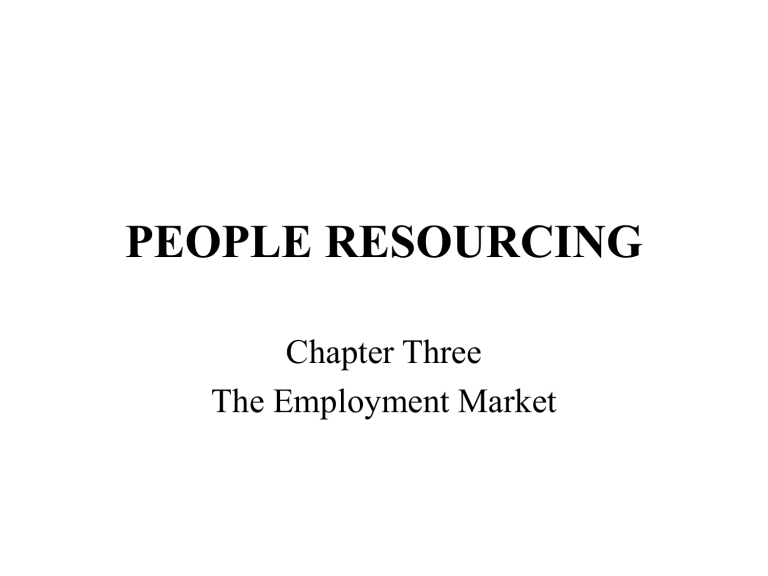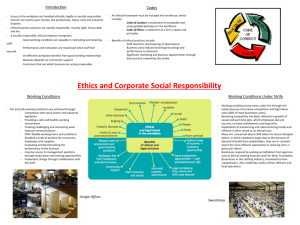people resourcing

PEOPLE RESOURCING
Chapter Three
The Employment Market
The term ‘labour markets’ refer to the employment markets in which organisations are obliged to compete with one another in order to acquire the services of employees.
Conditions vary considerably over time and across different types of employment.
• ‘Tight’ market implies fierce competition for talent
• ‘Loose’ market implies that potential employees are in plentiful supply
Following the end of the 1989–92 recession, there was a steady tightening of UK labour markets as overall unemployment levels fell.
There have been conflicting views about whether this will last, however:
1) Case for seeing the tightening and loosening of labour market conditions as cyclical in nature
2) Case for arguing that tight labour markets are more likely to become the norm – supported by trends such as the ageing population and the changing nature of the work to be done.
Competing in a tight labour market
Reduced number of people with the required attributes looking to work in the jobs that are available.
People resourcing consequences:
• Recruitment activities (more sophisticated advertising; considering wider applicant pools; luring back ex-employees)
• Retention initiatives
• Reorganisations – ‘skill mix review’
• Development initiatives.
Employers should also be aware of the effect on the power balance. Employees will be more demanding in terms of autonomy, flexibility, working conditions, development opportunities and pay.
Due to a number of demographic changes, a new labour market is evolving, and employers will have to be ready.
• The average age of the working population is increasing.
• P&D policies will have to be adapted to attract and retain individuals with different needs:
- older workers (flexible working, etc)
- overseas immigrants (language and cultural training).
• Greater attention must be given to human resource planning processes.
• Occupational pension schemes.
Changing attitudes to work and the workplace.
‘Generation Y’ (those born after 1980s) entering the workforce have different values and expectations:
• acceptance of ongoing technological change
• intolerance of discrimination
• requirement for work–life balance
• commitment to ethical practices
• awareness of the global perspective
• resistance to tight systems of control
• greater ease with change and uncertainty
• less loyalty to one employer.
Work–life balance (WLB)
WLB initiatives are becoming more prominent for a number of reasons:
• operational requirements
• longer hours of operation
• regulation
• labour market reasons – understanding that employees value work–life balance, and the company stance will have a significant impact on recruitment and selection.
Types of work–life balance initiative:
• flexible working: part-time, compressed hours, term-time working, jobsharing, flexitime, homeworking
• leave, time off, career breaks
• childcare facilities
• health and well-being.
Employer branding
Developed in the last years of the twentieth century as labour markets tightened and it became harder to recruit and retain staff.
For products, the merits of a brand include:
• it signifies recognisable quality, reliability or value for money
• it differentiates one product or service from others
• it encourages familiarity
• it engenders loyalty
• less advertising is needed.
Employer branding seeks to apply these same principles to the field of employment – helping a company become an ‘employer of choice’.
Especially useful for organisations that do not have a strong corporate brand: smaller companies, start-ups, regionally-based companies, etc.
Two stages to employer branding:
1) Identifying differentiator
• prestige
• cause
• high risk/big potential
• work–life balance
2) Communication – ‘leveraging the brand’ by finding creative ways to communicate the core messages, and using appropriate language.
Employing people from overseas
Net migration into the UK has increased considerably since the turn of the century. This has caused the total population to grow by 2 million between 2000 and 2006.
A major reason is the accession of 10 new countries into
EU membership in 2004, the UK being one of just three existing member states to permit citizens to enter freely in order to seek work.
Across the country as a whole, one in every eight employees was born overseas.
P&D consequences:
• More culturally and racially diverse workforce
• Culturally sensitive policies and practices
(recruitment, retention, performance management and motivation)
• Training of managers in cultural differences and effective cross-cultural communication.
When developing people resourcing initiatives, P&D practitioners should consider cultural differences:
• openness with personal ambition v modesty
• egalitarian cultures v deference to authority
• formal meetings with pre-agreed agenda building personal relationships v time spent
• emphasis on competencies educational qualifications v reverence for
• direct v indirect styles of communication.
Ethical questions
Can we always clearly determine the ‘ethical path’?
Differing perspectives:
1) The market economy is virtuous in its own right. As the engine of wealth creation, its long-term health is in the interest of everyone across the globe, rich and poor alike.
2) All do not benefit alike from the advance of ‘unbridled capitalism’. Some benefit far more than others, while a third group hardly benefits at all. The focus is on the notion of human rights, and the presence of responsibilities which are owed by the relatively strong to the relatively weak.
In a tight labour market it is especially important to manage staff within an ethical framework that they and their successors share.
This is not easy to maintain in practice, and P&D practitioners are often faced with ethical dilemmas.
An ‘abuse of power’ for example, can occur for several reasons:
• organisational politics/management egos
• business needs of the organisation
• no clear statement of what is ethical.
Ideal world: A firm and agreed statement of business ethics
Reality: General ethical standard and methods for influencing decision-making:
• Look for a balance between ethical considerations and the long-term survival and financial success of the organisation.
• Treat everyone consistently.
• Apply the basic principles of natural justice
(honesty and fairness).
• Use argument and not power to determine outcomes.
When trying to influence a specific decision, there are several categories of argument: a moral, a business or a legal case.






